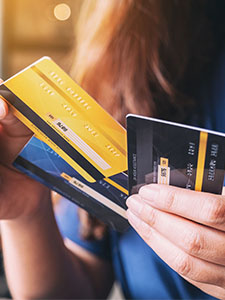Blog posted On November 17, 2021

Credit cards are useful for quick payments and things like monthly bills. But they often have higher interest rates than personal loans, which can make paying them off harder. If you’re thinking about making a large purchase (home renovation, household appliance, holiday gift), then you might want to explore your other options.
Benefits of using your credit card for large purchases
There are many payment options that offer lower interest rates than credit cards. But charging big purchases to your credit card has perks sometimes too!
Some credit cards offer sign-up bonuses and rewards. If you sign up for a credit card with certain companies, you can earn rewards like cashback, points, or miles. In order to qualify for these rewards, you may need to spend a certain amount of money within the first few months of signing up. Therefore, if you have a large purchase you need to make, this could be a good opportunity to earn credit card rewards. However, it’s never a good idea to make a large credit card payment simply for the rewards. If you make a large credit card purchase that you actually can’t afford, this could put you in a bad position very quickly.
Other pros of using a credit card for a large purchase include 0% APR periods and cardholder benefits. If you’ve just gotten a new credit card with a 0% intro APR period, a large purchase might be worth charging. Cardholder benefits can include extended warranties, purchase protection, or travel insurance. For example, if you buy a refrigerator with a one-year manufacturer warranty, your credit card company may offer an additional year of coverage. But once again, if it’s a purchase that you can’t afford, then don’t buy it.
Alternatives to using your credit card for large purchases
If you want to avoid debt and interest charges, dipping into savings might be your best bet. This way, you don’t owe any bank or credit card company money and interest. You’ll simply need to build back your savings. But if one single purchase will put a significant dent into your savings, then it might not be the best idea. A good rule of thumb is keeping at least three to six months of expenses in your savings in case of an emergency.
Alternatives to dipping into savings or incurring high-interest debt is a cash-out refinance. With a cash-out refinance, you use your home equity to pay off your current mortgage, replace it with a new mortgage that is higher than your current remaining balance, and receive cash for the difference between the two. Though you can use the cash however you please, financial experts recommend you use it for high-return investments like a renovation or consolidating high-interest debt. For example, if your home is valued at $400,000 and your current mortgage balance is $300,000, you have $100,000 in home equity. With a cash-out refinance, your new loan could be $380,000, giving you $20,000 in cash. To calculate your savings in interest, you can use our mortgage calculator.
A HELOC is a Home Equity Line of Credit. Like a cash-out refinance, a HELOC utilizes your passive home equity. Unlike a cash-out refinance, a HELOC lets you pull equity whenever you need (as opposed to one lump sum). A HELOC can be a better alternative to credit cards for large purchases because it’s at a lower interest rate. It can also be a better option than cash-out refinances if you plan to use it more than once.
Using a credit card for certain purchases has its benefits, but it also means higher interest rates if you can’t pay the balance right away. If you would like to explore the HELOC or cash-out refinance alternatives, let us know and we would be happy to help.
Sources: Bankrate